Early ripe Parisian gherkin cucumbers for the most delicious winter preparations
Gherkins are cucumbers that grow no more than 10 cm in length. Such small fruits have a rich taste with pronounced sweet notes. They remain crispy even when preserved. This is why gardeners and housewives love them so much.
One of the most famous varieties of such cucumbers is the Parisian gherkin. They are distinguished not only by their miniature greens, but also by their increased resistance to adverse factors. How to grow this hybrid on your site and whether it is suitable for growing for sale, read on.
Description of the hybrid
Parisian gherkin is a hybrid of cucumbers. Despite its name, it has nothing to do with France. The hybrid was developed by the domestic company Poisk.
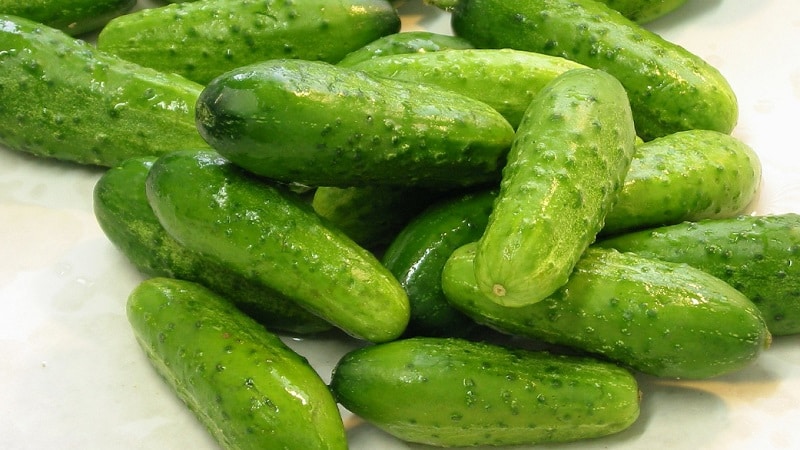
In 2006, the Parisian gherkin was included in the Russian register and quickly gained popularity among gardeners in the CIS countries.
Attention! Seeds collected from the fruits of the Paris gherkin are not suitable for cultivation. They will grow into plants that have parental characteristics.
Distinctive features
The main distinguishing feature of Parisian gherkins is the size of their fruits.. The greens, collected in a timely manner, are thin, their length does not exceed 6-10 cm. The crispy, dense fruits have a rich sweetish taste and cucumber aroma.
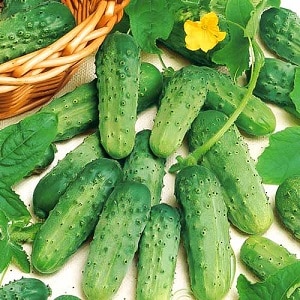 Look what the gherkins look like in the photo.
Look what the gherkins look like in the photo.
Another positive feature of the hybrid – drought resistance. Parisian gherkins are not afraid of elevated temperatures and lack of watering.
Cucumbers also have immunity to diseases.characteristic of this culture. Its resistance to fungal infections is especially strong.
Negative feature of the hybrid – it requires quick harvesting. If the fruits hang on the bush, they will turn yellow, acquire a rounded shape, and become tasteless and uncrisp.
Composition properties, benefits, calorie content
Gherkins, like other cucumbers, are more than 90% water. Per 100 g there are 12-14 kcal, 0.8 g protein, 0.1 g fat, 2.4 g carbohydrates.
Contains cucumbers contains a large number of useful substances. Among them are groups of vitamins (C, K, B, A), minerals (copper, chlorine, magnesium, calcium, potassium, sodium) and chaolin.
Fruit Helps the body get rid of harmful substances: toxins, waste, radicals, cholesterol, helps improve the condition of hair and skin, normalizes liver function.
Main characteristics
The Parisian gherkin is very popular in Russia for its taste and ease of care.

Description of the hybrid:
| Options | Indicators |
| Bush type | Indeterminate. Long climbing plant. The ground part is medium-branched, covered with an average amount of foliage. The leaf blade is ordinary, medium in size. A large number of female flowers are formed. Insects are needed for pollination. |
| Fruit | Small gherkins. The length of the fruit is 6-10 cm. The weight reaches 70-90 g. They have a spindle-shaped shape. The skin is covered with large spines with black hairs. The color is rich green. There are thin light planes. The taste is sweet, without bitterness. The aroma is rich, cucumber. The pulp is medium dense, juicy and crispy. |
| Productivity | Average. From 1 sq. m harvest up to 5 kg of fruit. |
| Ripening time | Early. The first harvest is harvested 35-40 days after sowing the seeds. |
| Growing method | Suitable for growing in open ground. Cultivation in a greenhouse is also possible, subject to artificial pollination. |
| Transportability | High. The fruits have a thin but durable skin that protects them from damage during transportation. Stored in a cool place for 3 weeks. |
| Disease resistance | High immunity to tobacco mosaic virus, powdery mildew, peronosporosis, cladosporiosis. |
Note! Parisian gherkins are recommended for cultivation in open ground in the central and southern regions. Reviews from gardeners indicate that this variety is suitable for cultivation in cities with a northern climate.
How to grow this variety yourself
Parisian gherkins are grown both in open ground and in greenhouses. In both cases, the soil in the beds is prepared in the fall.
Important! When planting Parisian gherkins in a greenhouse, the gardener must be prepared for the fact that the plants will have to be pollinated artificially. This is done with a soft brush or by plucking male flowers and applying them to the female ones. When growing cucumbers on an industrial scale, pollinating insects, such as bumblebees, are specially released into greenhouses.
Semi-shaded areas of the garden are chosen for cucumbers.. If the planting site is located in full sun, then tall crops, such as corn, are planted on both sides of the beds.
In autumn, the beds are dug up and cleared of plant debris.. It is not necessary to throw away the collected grass; some gardeners tear it up, water it with a solution of potassium permanganate and bury it back in the ground. In spring, rotted vegetation becomes fertilizer.
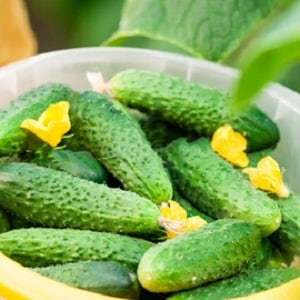 The soil is also mixed with humus or manure. For 1 sq. m take 6 kg of fertilizers.If the acidity of the soil is increased, then add dry lime or ash. If the soil is heavy, then its top layer is mixed with sand.
The soil is also mixed with humus or manure. For 1 sq. m take 6 kg of fertilizers.If the acidity of the soil is increased, then add dry lime or ash. If the soil is heavy, then its top layer is mixed with sand.
In spring, the soil is leveled with a rake and cleared of weeds.. For 1 sq. m add 30 g of superphosphate and 20 g of ammonium nitrate. Then the beds are disinfected with a solution prepared from 10 liters of water and 1 tbsp. l. ammonium nitrate.
In 2-3 weeks they dig holes for planting. For 1 sq. m are placed three bushes of the Parisian gherkin. To save space, the recesses are arranged in a checkerboard pattern.
Fertilizers are poured directly into the holes. In most cases, a handful of ash and long-term mineral fertilizers are thrown into each hole. Experienced gardeners often add a layer of organic matter (humus or manure) to the bottom of the hole, which is mixed with the same amount of soil. After this, the depression is completely covered with earth without compacting it.
In this form, the holes will be drawn before planting.. All this time they are watered 2-3 times a week and weeds are removed. Immediately before planting, pour a liter of light pink solution of potassium permanganate into the recesses.
Other varieties and hybrids of cucumbers:
How to properly grow cucumber "Artist"
Early ripening Murashka cucumber that does not require pollination
Landing
Parisian gherkin grown by seedlings and without seedlings. In the first case, the harvest appears earlier.
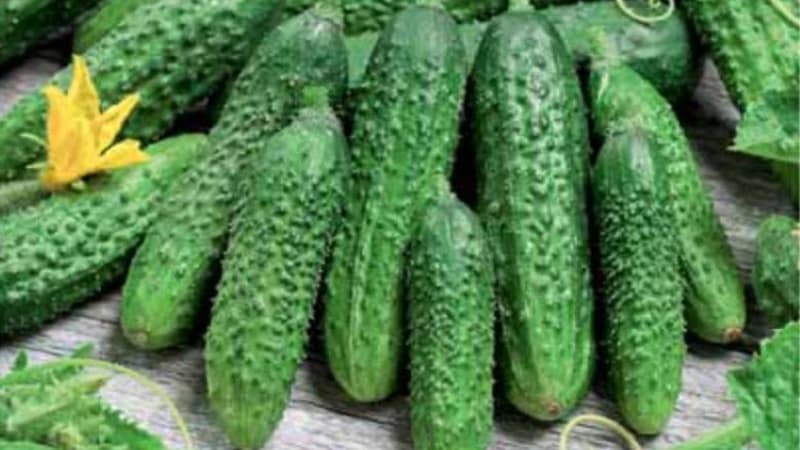
Many producers pane or glaze planting material. It is sold already treated with disinfecting compounds and covered with a shell consisting of nutrients. Information about processing is indicated on the packaging; such seeds are also painted in bright colors: red, green, orange.
If the seeds have not been processed in the factory, this is done at home. Preparation of planting material for planting consists of several stages:
- The package with seeds is placed near the battery for two weeks. Warmed planting material germinates faster.
- The seeds are immersed in a light pink solution of potassium permanganate or hydrogen peroxide for half an hour. Floated specimens are considered unsuitable for planting. In this way, the seeds are disinfected and tested for germination.
- After this, they are treated with nutritional compounds. They use purchased products, for example, “Sodium Humate” according to the instructions or use homemade preparations. To prepare a growth stimulator, add 1 tsp per 1 liter of liquid. nitrophoska and ash.
Most gardeners prefer germinate and harden seeds in advance. This accelerates the emergence of first shoots and increases the cold resistance of plants:
- The seeds are wrapped in pieces of material moistened with warm water. They are placed in a saucer and covered with film. In this form, the planting material is kept until pecking (2-3 days) at a temperature of 25-27 °C. The material is moistened as it dries.
- The hatched planting material is placed in the refrigerator for 24 hours. This is necessary for its hardening.

Seed method
Seeds are sown in open ground when the soil warms up to 15 °C at a depth of 15 cm. The time for sowing seeds depends on the growing method:
- in greenhouses - in early May;
- in open ground under film - in the second half of May;
- in open ground without film - at the end of June.
Important! The seed method of growing cucumbers is acceptable only for regions with warm climates.
Before planting, the holes are watered abundantly.. One seed is planted in each hole, placing them in the center of the hole.The planting material is deepened by 4 cm. The soil around them is not compacted.
It is recommended to cover the beds with film after sowing the seeds.. Every day in warm weather it is opened slightly for ventilation for 1-2 hours. The shelter is removed after all the plants have germinated.
Rassadny
Parisian gherkins It is recommended to grow using seedlings. In this case, the seeds are sown already in the second half of April.
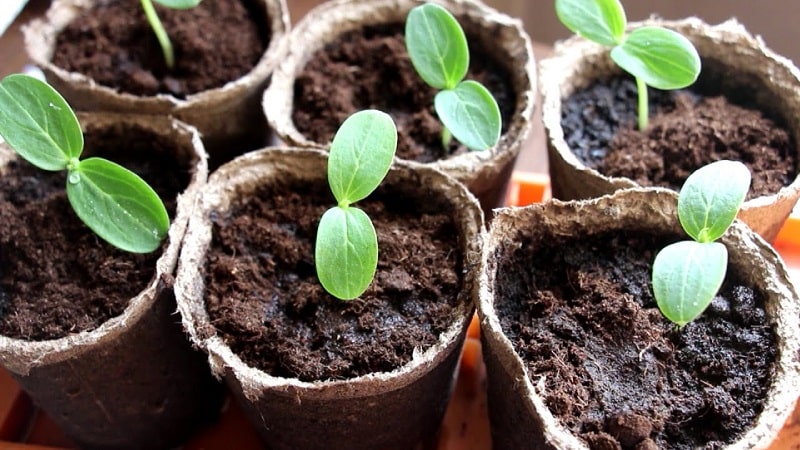
For seedlings, soil can be purchased at the store or prepared independently. The simplest version of the soil mixture is equal proportions of peat and black soil, half a portion of sawdust. Add a glass of ash and 1.5 tbsp to a bucket of soil. l. nitrophoska. All ingredients are thoroughly mixed. Be sure to use drainage. Coarse sand will do. The soil and drainage are disinfected with a dark pink solution of potassium permanganate, boiling water or in the oven.
Cucumber seeds are sown immediately in individual cups at least 15 cm deep. It is most convenient to use peat containers, which do not need to be removed when picking seedlings to a permanent place. There must be drainage holes in the bottom of the container.
Place 2 cm of soil at the bottom of the pots. The remaining space is filled with soil. It is watered with warm water before sowing planting material.
Advice! If the soil was in a cool place, then before using it, bring it indoors and allow it to warm up to room temperature.
1 seed is sown in each pot, deepening by 2 cm. The containers are covered with film and placed in a warm place with a temperature of 25-27 °C.
After emergence of shoots, the film is removed. The cucumbers are moved to a well-lit place (if necessary, use a fluorescent lamp).
When 2-3 leaves appear, the plants are permanently planted in pre-prepared holes along with a lump of earth. The root collar is not deepened into the soil.
Read also:
Growing and care
Parisian gherkins are tied to a support after the appearance of the fifth leaf. Usually trellises are used, to which plants are attached as they grow with synthetic thread. This not only protects the bushes from damage, but also promotes better ventilation of the plants.
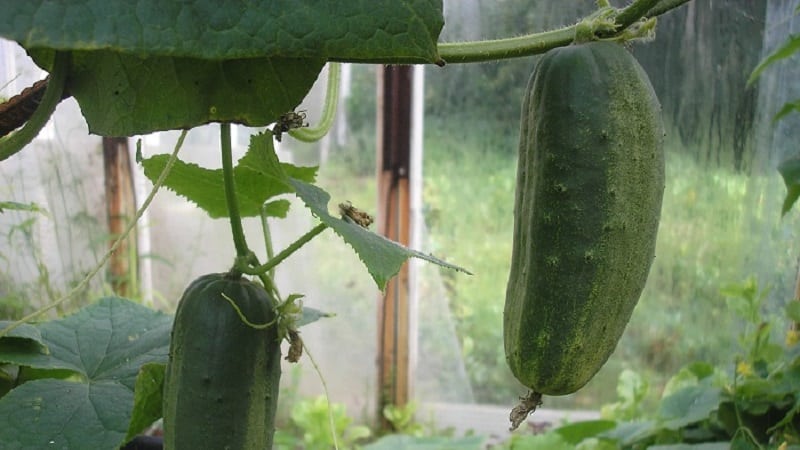
cucumbers water as the top layer of soil dries out. For 1 sq. m use 7 liters of water at room temperature. After each watering, the soil is loosened to remove weeds.
It is recommended to cover cucumber beds with mulch. (rotted straw, hay or humus). This layer will protect the root system from hypothermia and pests, and will also slow down the growth of weeds.
Feed cucumbers every two weeks before fruit formation. Typically, a product prepared from the following components is used: per 10 liters of water, take 30 g of superphosphate, urea and potassium sulfate. For 1 sq. m use 5 liters of the drug.
Features of cultivation
To get a rich harvest and avoid many problems, gardeners use the following techniques:
- Before flowers appear, cucumbers are watered with rain once every 5 days. After flowering begins, the plants are watered daily, only at the root. The best time for watering is early morning or evening.
- Plants in open ground are pollinated by insects. To attract them, cucumbers are sprayed with sweet water or fragrant flowers, such as calendula, are planted between the beds.
- In the greenhouse, cucumbers are pollinated artificially.To do this, it is important to be able to distinguish female flowers from male ones (there is a small cucumber at the base of female flowers). Pollen is transferred from male flowers to female flowers with a soft brush.
Diseases and pests
Cucumbers Parisian gherkin is highly resistant to fungal and viral diseases. Gardeners prefer not to treat them with chemicals to obtain an environmentally friendly product.

All prevention is following the rules of watering and preparing planting material, disinfecting garden tools and observing crop rotation (cucumbers are not planted in beds after melons).
Protecting plants from insects is important. For prevention purposes, the bushes are treated with a soap solution (a bar of soap in a glass of water). If plants are already damaged by insects, use the following drugs:
- "Fufanon";
- "Kemifos";
- infusion of 200 g of chopped garlic in 6 liters of water (infuse for 7 days).
Harvesting and application
IN characteristics say that the Parisian gherkin is an early ripening hybrid. Its harvest begins in early June. It is recommended to pick fruits that have reached the desired size every other day. Otherwise, they barrel, turn yellow and taste watery.
Parisian gherkins are used for fresh consumption and pickling.. According to reviews from gardeners, they are not suitable for pickling.
Advantages and disadvantages of a hybrid
Benefits of Parisian gherkins:
- high productivity;
- small tasty fruits;
- early ripeness;
- resistance to drought and heat;
- immunity to disease;
- no need for stepsoning;
- One hundred percent germination of seeds.
Disadvantages of a hybrid:
- the impossibility of using seeds from your own harvest for planting;
- the need for frequent fruit collection.
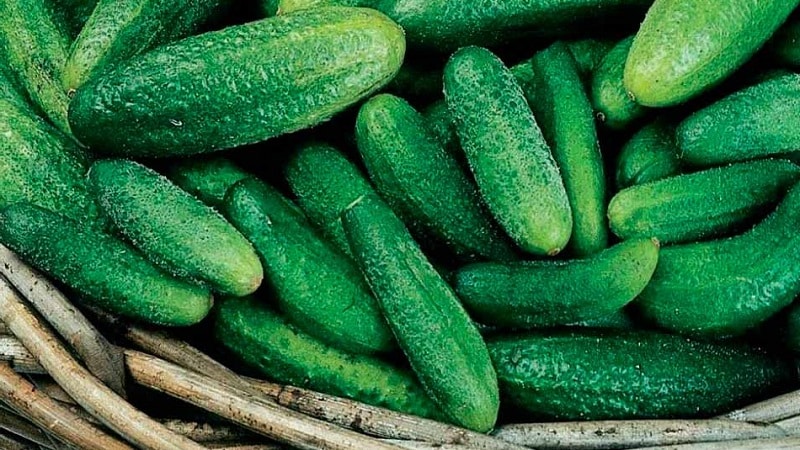
Reviews
Reviews from gardeners about the Parisian gherkin are mostly positive. This hybrid will not appeal only to those who do not like gherkins.
Vasilisa, Rostov: “I’ve been planting the Parisian gherkin for several years now. I really like the bright crispy cucumbers, small as in the photographs. For salads, it is, of course, better to take larger cucumbers. These look beautiful sitting on the table as a whole. In the marinade they turn out very tasty and beautiful, it’s not a shame to serve on a festive table.”.
Oleg, Sochi: “I chose Parisian gherkins based on admiring reviews. Really cool little cucumbers. They are very easy to grow, but they quickly outgrow them. And not in length, but in breadth, becoming almost round. I liked it fresh. But we don’t pickle cucumbers for the winter, we just salt them. Not suitable for these purposes at all.".
Conclusion
Parisian gherkin cucumbers are a real find for lovers of miniature greens. They are good fresh or pickled. Those who have tried them note the sweet, crisp flesh, which does not become bitter even with a lack of watering.
Despite the fact that the hybrid is not afraid of drought, disease and does not require stepsoning, it is not suitable for summer residents who do not live in the country all the time. The harvest must be harvested every two days, otherwise the fruits will become ugly and watery.